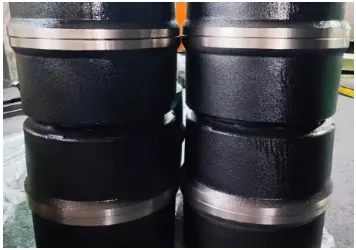Jan . 25, 2025 01:51
Terug na lys
disc brake drum brake difference
When it comes to modern vehicular braking systems, understanding the differences between disc brakes and drum brakes can significantly enhance both safety and performance awareness for virtually any driver. As an automotive enthusiast with decades of real-world experience, I aim to shed light on this critical aspect of automotive technology.
Expertise in automotive technology often involves evaluating the nuanced feel each system provides. For performance-oriented vehicles, drivers often prefer the firmer, more immediate response of disc brakes. This responsiveness and brake modulation offer crucial feedback, especially at higher speeds. In contrast, drum brakes tend to provide a softer, spongier pedal feel, which some drivers might find less inspiring but can be beneficial in non-performance scenarios due to the more gradual application of braking force, ideal for smooth stops in everyday driving. One authoritative perspective on the subject is the safety implications of each system. Disc brakes generally lead the pack, with superior stopping power and reduced fade under repeated hard braking—crucial for emergency stops. Yet, for countries where cost considerations play a significant role in decision-making, drum brakes remain a viable choice for manufacturers due to their lower production cost and simplicity in rear-wheel setups of many vehicles. As automotive technology evolves, newer innovations continue to blur the distinctions between these two systems, with advanced materials and electronic systems enhancing both disc and drum brakes. Trustworthiness in selecting or recommending a braking system is thus inherently linked with understanding these advancements' context, along with the specific use-case scenarios for different types of vehicle usage. In conclusion, the choice between disc and drum brakes hinges on multiple factors—efficiency, cost, application, and driver preference—influenced by expert knowledge and personal or market-based priorities. While disc brakes generally lead in performance metrics, drum brakes still hold relevance in specific niches. Ultimately, understanding these differences empowers informed decision-making, enhancing vehicle safety and overall driving satisfaction.


Expertise in automotive technology often involves evaluating the nuanced feel each system provides. For performance-oriented vehicles, drivers often prefer the firmer, more immediate response of disc brakes. This responsiveness and brake modulation offer crucial feedback, especially at higher speeds. In contrast, drum brakes tend to provide a softer, spongier pedal feel, which some drivers might find less inspiring but can be beneficial in non-performance scenarios due to the more gradual application of braking force, ideal for smooth stops in everyday driving. One authoritative perspective on the subject is the safety implications of each system. Disc brakes generally lead the pack, with superior stopping power and reduced fade under repeated hard braking—crucial for emergency stops. Yet, for countries where cost considerations play a significant role in decision-making, drum brakes remain a viable choice for manufacturers due to their lower production cost and simplicity in rear-wheel setups of many vehicles. As automotive technology evolves, newer innovations continue to blur the distinctions between these two systems, with advanced materials and electronic systems enhancing both disc and drum brakes. Trustworthiness in selecting or recommending a braking system is thus inherently linked with understanding these advancements' context, along with the specific use-case scenarios for different types of vehicle usage. In conclusion, the choice between disc and drum brakes hinges on multiple factors—efficiency, cost, application, and driver preference—influenced by expert knowledge and personal or market-based priorities. While disc brakes generally lead in performance metrics, drum brakes still hold relevance in specific niches. Ultimately, understanding these differences empowers informed decision-making, enhancing vehicle safety and overall driving satisfaction.
vorige:
volgende:
Jongste nuus
-
The Power and Reliability of Brake DrumsNuusAug.27,2025
-
The High-Quality Truck Brake DrumsNuusAug.27,2025
-
Quality Brake Drums for Reliable PerformanceNuusAug.27,2025
-
Get the Quality Semi Trailer Brake Drums for Your FleetNuusAug.27,2025
-
Everything You Need to Know About Brake DrumsNuusAug.27,2025
-
Enhance Your Vehicle's Performance with Reliable Brake DrumsNuusAug.27,2025
-
Truck Drum Brake Spring Replacement ProcedureNuusAug.22,2025


